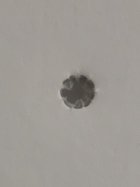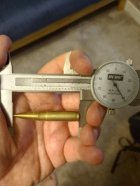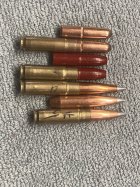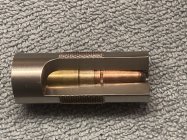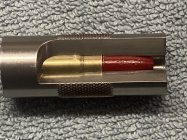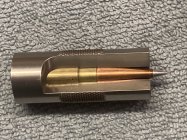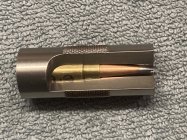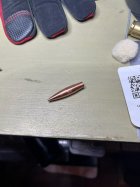Just to confirm, you want the bearing surface to still be in the case when the ogive engages the rifling? That's a new one to me but it sounds reasonable. If I extend the bearing surface I have to either cut back on the ogive or the spike to keep the amount of stability I have.
I honestly can’t answer that question. What I think I prefer and why, may not hold up to scrutiny.
The problem with the 300 Blackout chamber is that it’s not what you would call a match chamber. It was designed to pitch to the military with a 2 MOA requirement out to I think 500 yards. The cartridge flops around in the chamber like a fish out of water, so you can pour in a pound of sand and still feed.
More to the point, and this is the stuff long arguments come from, is what exactly is the firing process once the primer is ignited.
Does the primer pressure force the bulllet into the lands, before the powder ignites annd expands the neck, is the question. Part of the answer will be how far does the bullet have to travel. So there is no absolute answer. If powder or gas blown past the bullet, is not desirable.
One thing that is not disputable is the angle of entry to the bore is critical. Your bullet travels .060-.080” from case mouth to lands un supported. Seems to me that would be a potential for a sideways entry. I would say in my experience, those bullets that float never seem to be the most precise. Others that have it figured out might have a different experience, then again, they might have a chamber with tolerances that allow that.
Here, feed back from others would be appreciated.
What I can show you is bullets that were designed for the cartridge, and the bullet the cartridge was basically designed around. Also included was the G9 bullet that held MOA groups out past 500 yards.
This is one of the best uses of a chamber gauge cut with an actual reamer with length being Max SAAMI. If the bullet pokes out the end, it’s too long for a standard magazine. Better to find out this way if a bullet can be loaded to max. One surprise bullet is the 110 VMax can be jammed with about .020” left in the case. Great visuals.
The chamber was designed so that a 240 or 220 SMK would be .010” off the lands at 2.260”. Here’s a 240
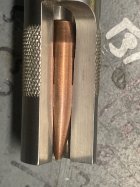
Sierra also made the first bullet specifically for the cartridge, the 125 SMK.
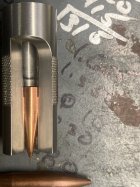
One of the most popular the 110 Barnes Black tip.
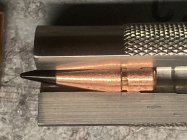
The G9 154 Grain bullet. No longer produced.
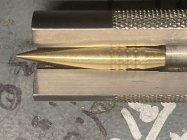
Note that the G9 will probably have less surface contact, but at least two bands will
Always be in the neck.
And just for fun the 250 ATip touching the lands and magazine length.
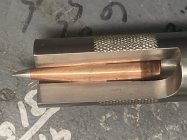

Early cartridge target shooters used a method called breech seating. The bullet was seated fully into the chamber, often with a mechanical tool that incorporates a fired in that chamber case. The bullet was seated so that about half the base was engraved into the rifling. Rule of thumb about .060” ahead of the charged cartridge case. Kind hard of to argue neck tension with that method, and may be closer to your artillery experiences.
Do the math on your bullet at 2.240. Only need the case length. If it’s like most brass around 1.360”.
I had varyimg lengths on your bullet due to the Spike. So this will be off some.
Case length + bullet length - overall length = seated depth.
Seated depth - boat tail = bearing surface in the neck.
1.360 + 1.300 - 2.240= .420
.420-.400= .020” in the case.
Hand fed single shot you can get away with that. Rounds bouncing around in a magazine due to recoil are probably going to end up seated crooked.










